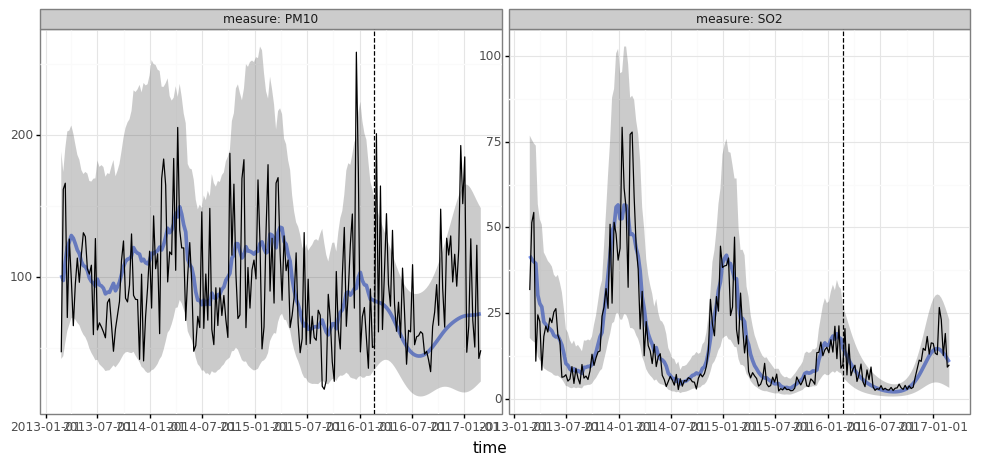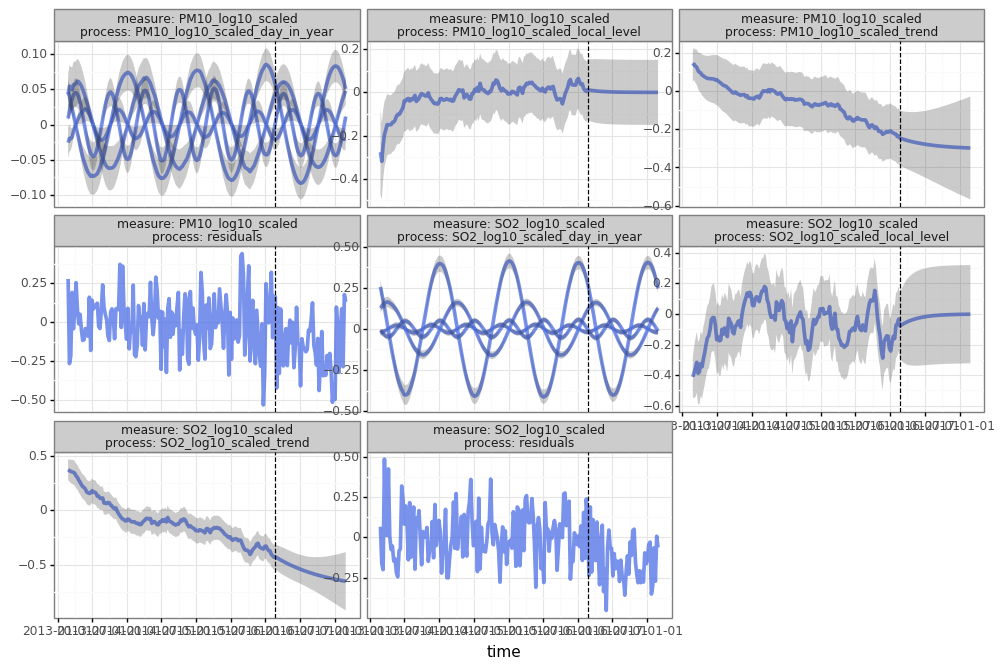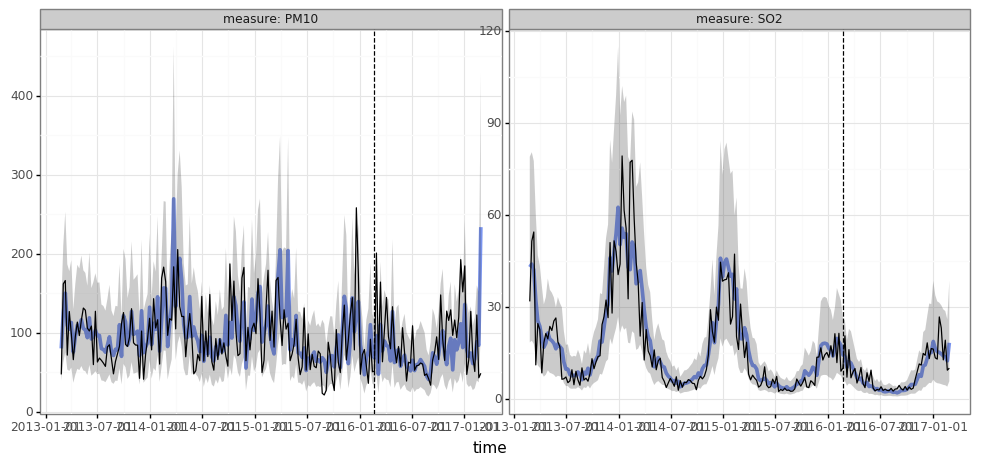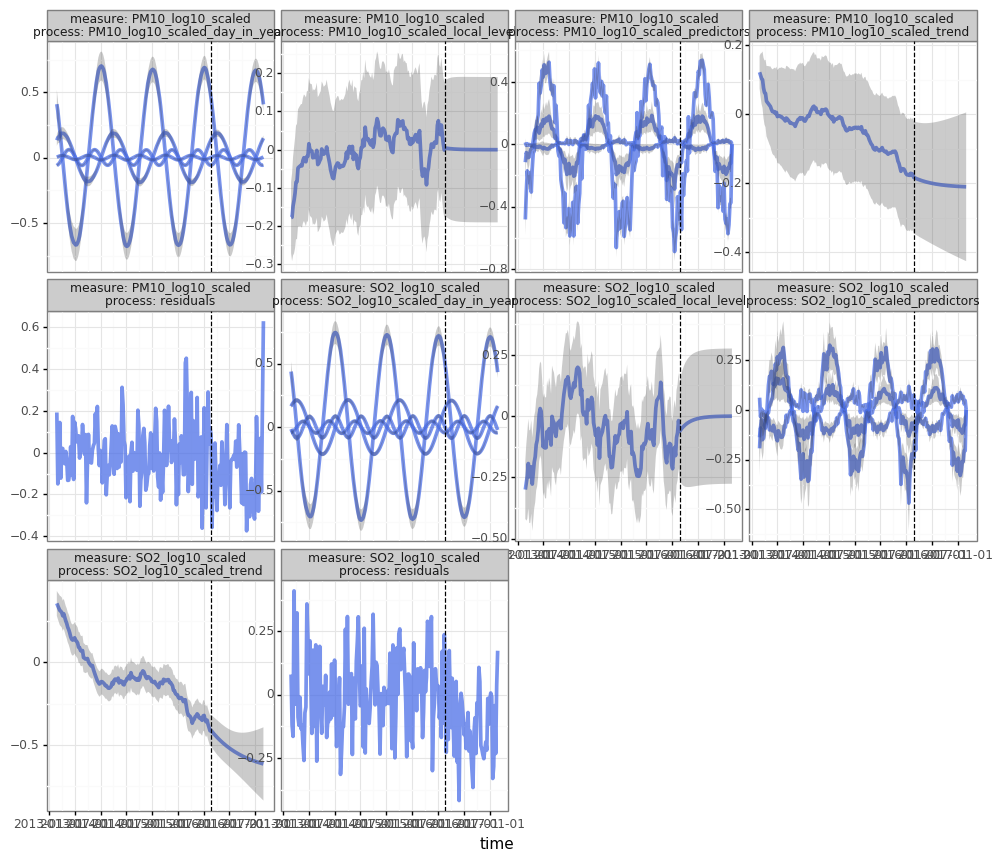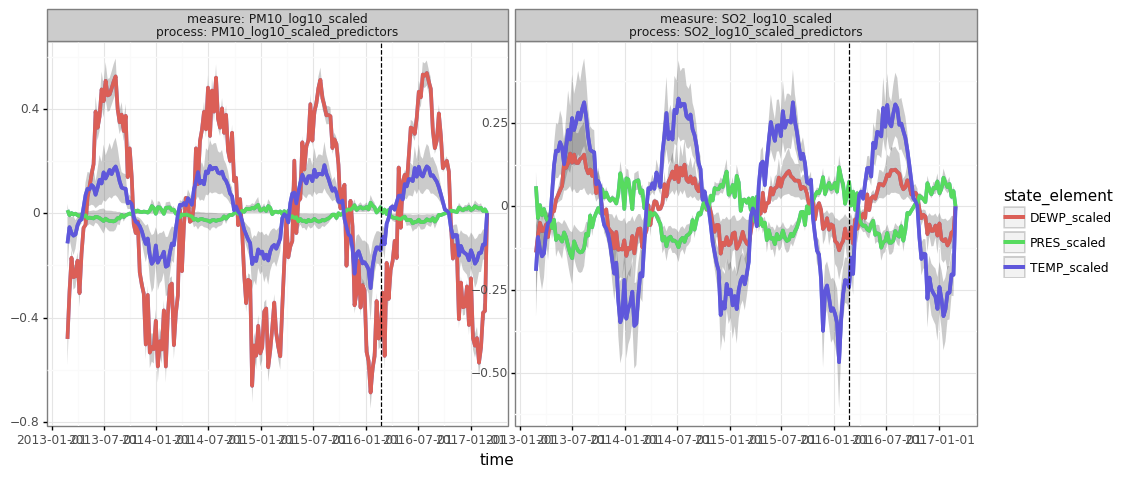Time-series forecasting models using Kalman-filters in PyTorch.
pip install git+https://github.com/strongio/torch-kalman.git#egg=torch_kalman
This dataset comes from the UCI Machine Learning Data Repository. It includes data on air pollutants and weather from 12 sites. To simplify the example, we'll focus on weekly averages for two measures: PM10 and SO2. Since these measures are strictly positive, we log-transform them.
df_aq_weekly.loc[:,['date','station','SO2','PM10','TEMP','PRES','DEWP']]| date | station | SO2 | PM10 | TEMP | PRES | DEWP | |
|---|---|---|---|---|---|---|---|
| 0 | 2013-02-25 | Aotizhongxin | 36.541667 | 57.791667 | 2.525000 | 1022.777778 | -15.666667 |
| 1 | 2013-03-04 | Aotizhongxin | 65.280906 | 198.149701 | 7.797619 | 1008.958929 | -7.088690 |
| 2 | 2013-03-11 | Aotizhongxin | 57.416667 | 177.184524 | 6.402976 | 1014.233929 | -2.277976 |
| 3 | 2013-03-18 | Aotizhongxin | 19.750000 | 92.511905 | 4.535119 | 1009.782738 | -5.529762 |
| 4 | 2013-03-25 | Aotizhongxin | 41.559006 | 145.422619 | 6.991071 | 1012.829762 | -3.762500 |
| ... | ... | ... | ... | ... | ... | ... | ... |
| 2515 | 2017-01-30 | Wanshouxigong | 27.666667 | 119.059524 | 0.768304 | 1024.101984 | -18.331548 |
| 2516 | 2017-02-06 | Wanshouxigong | 15.544910 | 61.395210 | 0.625298 | 1025.392857 | -16.977381 |
| 2517 | 2017-02-13 | Wanshouxigong | 26.166667 | 139.613095 | 2.870238 | 1019.840476 | -11.551190 |
| 2518 | 2017-02-20 | Wanshouxigong | 7.020833 | 46.372414 | 3.425000 | 1022.414881 | -11.811905 |
| 2519 | 2017-02-27 | Wanshouxigong | 9.613636 | 52.955556 | 9.647917 | 1016.014583 | -9.964583 |
2520 rows × 7 columns
One of the key advantages of torch-kalman is the ability to train on a batch of time-serieses, instead of training a separate model for each individually. The TimeSeriesDataset is similar to PyTorch's native TensorDataset, with some useful metadata on the batch of time-serieses (the station names, the dates for each).
# preprocess our measures of interest:
measures = ['SO2','PM10']
measures_pp = [m + '_log10_scaled' for m in measures]
df_aq_weekly[measures_pp] = np.log10(df_aq_weekly[measures] / col_means[measures])
# create a dataset:
dataset_all = TimeSeriesDataset.from_dataframe(
dataframe=df_aq_weekly,
dt_unit='W',
measure_colnames=measures_pp,
group_colname='station',
time_colname='date',
pad_X=0.0
)
# Train/Val split:
dataset_train, dataset_val = dataset_all.train_val_split(dt=SPLIT_DT)
dataset_train, dataset_val(TimeSeriesDataset(sizes=[torch.Size([12, 156, 2])], measures=(('SO2_log10_scaled', 'PM10_log10_scaled'),)),
TimeSeriesDataset(sizes=[torch.Size([12, 54, 2])], measures=(('SO2_log10_scaled', 'PM10_log10_scaled'),)))
The KalmanFilter subclasses torch.nn.Module. We specify the model by passing processes that capture the behaviors of our measures.
processes = []
for measure in measures_pp:
processes.extend([
LocalTrend(
id=f'{measure}_trend', multi=.01
).add_measure(measure),
LocalLevel(
id=f'{measure}_local_level',
decay=(.90,1.00)
).add_measure(measure),
FourierSeason(
id=f'{measure}_day_in_year', seasonal_period=365.25 / 7., dt_unit='W', K=2, fixed=True
).add_measure(measure)
])
kf_first = KalmanFilter(measures=measures_pp,
processes=processes,
measure_var_predict=('seasonal',dict(K=2,period='yearly',dt_unit='W')))Here we're showing off a few useful features of torch-kalman:
- We are training on a multivarite time-series: that is, our time-series has two measures (SO2 and PM10) and our model will capture correlations across these.
- We are going to train on, and predictor for, multiple time-serieses (i.e. multiple stations) at once.
- We are allowing the amount of noise in the measure (i.e., the measure variance) to vary with the seasons, by passing 'seasonal' alias to
measure_var_predict. (Themeasure_var_predictargument takes anytorch.nn.Modulethat can be used for prediction, but 'seasonal' is an alias that tells theKalmanFilterto use a seasonal NN.)
When we call our KalmanFilter, we get predictions (a StateBeliefOverTime) which come with a mean and covariance, and so can be evaluated against the actual data using a (negative) log-probability critierion.
kf_first.opt = LBFGS(kf_first.parameters(), lr=.20, max_eval=10)
def closure():
kf_first.opt.zero_grad()
pred = kf_first(
dataset_train.tensors[0],
start_datetimes=dataset_train.start_datetimes,
)
loss = -pred.log_prob(dataset_train.tensors[0]).mean()
loss.backward()
return loss
for epoch in range(15):
train_loss = kf_first.opt.step(closure).item()
with torch.no_grad():
pred = kf_first(
dataset_val.tensors[0],
start_datetimes=dataset_val.start_datetimes
)
val_loss = -pred.log_prob(dataset_val.tensors[0]).mean().item()
print(f"EPOCH {epoch}, TRAIN LOSS {train_loss}, VAL LOSS {val_loss}")EPOCH 0, TRAIN LOSS 2.372123956680298, VAL LOSS 1.0876796245574951
EPOCH 1, TRAIN LOSS 0.4992632269859314, VAL LOSS -0.6029616594314575
EPOCH 2, TRAIN LOSS -0.6929754018783569, VAL LOSS -0.6424744725227356
EPOCH 3, TRAIN LOSS -0.7372146248817444, VAL LOSS -0.6508392691612244
EPOCH 4, TRAIN LOSS -0.7536402940750122, VAL LOSS -0.6748760342597961
EPOCH 5, TRAIN LOSS -0.7693123817443848, VAL LOSS -0.7698904871940613
EPOCH 6, TRAIN LOSS -0.8141641020774841, VAL LOSS -0.7885841131210327
EPOCH 7, TRAIN LOSS -0.8502019643783569, VAL LOSS -0.7430527210235596
EPOCH 8, TRAIN LOSS -0.8761543035507202, VAL LOSS -0.6768094301223755
EPOCH 9, TRAIN LOSS -0.8880344033241272, VAL LOSS -0.6236486434936523
EPOCH 10, TRAIN LOSS -0.9021796584129333, VAL LOSS -0.6441830992698669
EPOCH 11, TRAIN LOSS -0.9108285307884216, VAL LOSS -0.6910713315010071
EPOCH 12, TRAIN LOSS -0.9218556880950928, VAL LOSS -0.6219266057014465
EPOCH 13, TRAIN LOSS -0.9351726174354553, VAL LOSS -0.6124213337898254
EPOCH 14, TRAIN LOSS -0.9403404593467712, VAL LOSS -0.6187482476234436
def inverse_transform(df: pd.DataFrame, col_means: pd.Series) -> pd.DataFrame:
df = df.copy()
df['measure'] = df['measure'].str.replace('_log10_scaled','')
std = (df['upper'] - df['lower']) / 1.96
for col in ['mean','lower','upper','actual']:
if col == 'mean':
# bias correction:
df[col] = df[col] + .5 * std ** 2
df[col] = 10 ** df[col] # inverse log10
df[col] *= df['measure'].map(col_means.to_dict()) # inverse scaling
return df
pred = kf_first(
dataset_train.tensors[0],
start_datetimes=dataset_train.start_datetimes,
out_timesteps=dataset_all.tensors[0].shape[1]
)
df_pred = inverse_transform(pred.to_dataframe(dataset_all), col_means)
print(pred.plot(df_pred.query("group=='Changping'"), split_dt=SPLIT_DT))print(pred.plot(pred.to_dataframe(dataset_all, type='components').query("group=='Changping'"), split_dt=SPLIT_DT))Here, we'll use the weather to predict our measures of interest. We add these predictors by adding a LinearModel process to our model. torch-kalman also supports using any neural network to generate latent states for our model -- see the NN process.
predictors = ['TEMP', 'PRES', 'DEWP']
predictors_pp = [x + '_scaled' for x in predictors]
df_aq_weekly[predictors_pp] = (df_aq_weekly[predictors] - col_means[predictors]) / col_stds[predictors]
dataset_all = TimeSeriesDataset.from_dataframe(
dataframe=df_aq_weekly,
dt_unit='W',
group_colname='station',
time_colname='date',
y_colnames=measures_pp,
X_colnames=predictors_pp
)
dataset_train, dataset_val = dataset_all.train_val_split(dt=SPLIT_DT)
# impute nans (since standardized, imputing w/zeros means imputing w/mean)
for _dataset in (dataset_all, dataset_train, dataset_val):
_, X = _dataset.tensors
X[torch.isnan(X)] = 0.0kf_pred = KalmanFilter(
measures=measures_pp,
processes=processes + [
LinearModel(id=f'{m}_predictors', covariates=predictors_pp).add_measure(m)
for m in measures_pp
]
)
kf_pred.opt = LBFGS(kf_pred.parameters(), lr=.20, max_eval=10)
def closure():
kf_pred.opt.zero_grad()
y, X = dataset_train.tensors
pred = kf_pred(y, predictors=X, start_datetimes=dataset_train.start_datetimes)
loss = -pred.log_prob(y).mean()
loss.backward()
return loss
for epoch in range(20):
train_loss = kf_pred.opt.step(closure).item()
y, X = dataset_val.tensors
with torch.no_grad():
pred = kf_pred(y, predictors=X, start_datetimes=dataset_val.start_datetimes)
val_loss = -pred.log_prob(y).mean().item()
print(f"EPOCH {epoch}, TRAIN LOSS {train_loss}, VAL LOSS {val_loss}")y, _ = dataset_train.tensors # only input air-pollutant data from 'train' period
_, X = dataset_all.tensors # but provide exogenous predictors from both 'train' and 'validation' periods
pred = kf_pred(
y,
predictors=X,
start_datetimes=dataset_train.start_datetimes,
out_timesteps=X.shape[1]
)
print(
pred.plot(inverse_transform(pred.to_dataframe(dataset_all).query("group=='Changping'"), col_means),split_dt=SPLIT_DT)
)
df_components = pred.to_dataframe(dataset_all, type='components')
print(pred.plot(df_components.query("group=='Changping'"), split_dt=SPLIT_DT))print(pred.plot(df_components.query("(group=='Changping') & (process.str.endswith('predictors'))"), split_dt=SPLIT_DT))